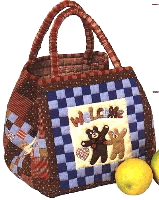 Cloth art is an important part of Chinese folk art. Women in the countryside usually fill cloth ware with grain or cotton to make certain symbolic moulds. Thanks to their exquisite techniques and beautiful patterns, Chinese cloth art products are well received by people from both home and abroad.
Cloth art is an important part of Chinese folk art. Women in the countryside usually fill cloth ware with grain or cotton to make certain symbolic moulds. Thanks to their exquisite techniques and beautiful patterns, Chinese cloth art products are well received by people from both home and abroad.
 Cloth-Piecing art
Cloth-Piecing art
Cloth art contains almost all living arts forms and has close ties with our daily lives. If cloth art creates a natural beauty of life, cloth-piecing art creates the most appealing artworks.
 Cloth-piecing art is said to be rooted in folk crafts in India. Artworks then mostly consisted of apparel and scarves, where patterns and color matching were formed in accordance with local religious customs. In the 12th and 13th centuries, when Europe fell prey to frequent cold snaps, people began making bedclothes by cloth piecing to stay warm. At the time, cloth-piecing techniques were more decorative rather than practical.
Cloth-piecing art is said to be rooted in folk crafts in India. Artworks then mostly consisted of apparel and scarves, where patterns and color matching were formed in accordance with local religious customs. In the 12th and 13th centuries, when Europe fell prey to frequent cold snaps, people began making bedclothes by cloth piecing to stay warm. At the time, cloth-piecing techniques were more decorative rather than practical.
In the 17th century, as a result of the discovery of the New World, many European puritans immigrated to America, bringing with them the art of cloth piecing. From then on, the art has spread throughout the world.
the world.
By the middle of the 19th century, cloth-piecing art had become an international trend. Although the materials consisted of scraps of cloth, the art had developed form a utility to a handicraft art.
The basic tools for cloth piecing are: a canvas and palette, scissors, pen, bead needle, ruler, needle, thread, thimble, seam ripper, embroidery border, awl, gyro wheel and paper. The basic materials include thin silk, velour, fine knops, cloth of various kinds, fasteners, etc. To master the art of cloth piecing, one has to acquaint him/herself with drawing basic pictures, color-matching, types and characteristics of cloth, tools and cloth clipping, etc. Cloth-piecing works can be used as cushions, frescos, pillows, baskets, furniture and ornaments.